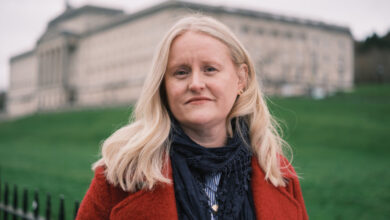Joining up justice
 Justice Minister David Ford explains how the different parts of the criminal justice system – and its partners in wider society – are working together to share ideas and deliver practical change.
Justice Minister David Ford explains how the different parts of the criminal justice system – and its partners in wider society – are working together to share ideas and deliver practical change.
The devolution of policing and justice powers in April 2010 brought with it new opportunities for our justice system. One of the biggest of these was the opportunity to develop and strengthen partnerships within and beyond government – the kind of joined-up approaches that are so critical to tackling the deep-seated issues that hamper our efforts to make our community safer.
The word independence is used a lot in the justice system, and rightly so.
I frequently find myself explaining, and defending, the operational independence of the police, prosecution service, and the judiciary.
But guarding operational, prosecutorial and judicial independence does not mean that the various components of the justice system must work in splendid isolation, and can’t work together to deliver a better system. So we have worked hard to develop stronger, more effective relationships across the system, and I believe each of those parts recognises that we have all benefited, in terms of outcomes, as a result.
Nor does the principle of independence mean that the justice system, on its own, can achieve the safer community that our citizens deserve. Indeed experience has convinced me, more than ever, of the need to work in partnership across the justice system, across all elements of government, and well beyond, working with and in communities in partnership with local organisations, engaging citizens themselves. No part of the system has all the answers, nor all the levers.
In recent weeks, I have seen first hand how some of these partnerships are beginning to make a difference. I have signed off on a joint application between the DoJ and the University of Ulster for funding for a project that will see academics and DoJ officials work alongside each other as we seek to reduce physical interface barriers.
I participated in the launch of a new autism guide for criminal justice professionals, developed jointly between DoJ and the National Autistic Society, and a new initiative involving DoJ, the PSNI, the Department of Agriculture and Rural Development and the National Farmers Union Mutual. And I have discussed with prison governors how placements in local businesses have given prisoners an opportunity to start new chapters in their lives.
These kind of partnerships, whether with private, voluntary or statutory sector organisations, have helped us make real strides in reforming the operation and purpose of our prison system.
Within the Executive, my department is working closely with DHSSPS on the Mental Capacity Bill and on a joint justice healthcare strategy, as well as contributing to an inter-departmental fund for early intervention projects – using justice funds to try to tackle the issues that impact very early on in the lives of many of the people we see in the justice system later on. Our work with DHSSPS and the PSNI has seen real improvements in the way we respond to the needs of those who have suffered the traumatic experience of domestic or sexual violence.
Intervention
We are also engaged with the Department for Employment and Learning on a range of initiatives, from a partnership between DEL’s Career Service and the Youth Justice Agency to the development of the first employability strategy for the Prison Service.
Other departments are also working with us, helping us to ensure that our strategic framework for reducing offending delivers on its ambitions. The roots of offending behaviour are planted well outside the justice system, so inter-departmental approaches are needed to tackle the factors that lead people into criminal behaviour, and the obstacles that prevent them moving out of it.
This framework, which DoJ officials have worked alongside colleagues within and beyond other departments to develop, embodies the real benefits of devolution: local partnerships; local solutions; local accountability.
And joining statutory bodies and local communities in partnership is at the very heart of our new policing and community safety partnerships. The strength of these partnerships lies in the fact that they reflect and understand their community and can deal quickly and effectively with the issues of local concern.
PCSPs are key front-line partners in the delivery of community safety, and I want to see them empowered and equipped to respond to local priorities with the kind of speed, flexibility and creativity that is difficult to match in central government.
These are just a few examples of the many partnerships that we have put in place. I could mention many more – the inter-agency group that is working closely with the interface community partners to help take forward opportunities for change; the Organised Crime Task Force which brings together all of the bodies who are committed to tackling this scourge on our society; the Anti-social Behaviour Delivery Group – with representatives from DoJ, PSNI, the Housing Executive, Solace, DSD, the Federation of Housing Associations, the Policing Board, the Fire and Rescue Service, Include Youth, and, of course, PCSPs.
The ambition of reshaping and improving our justice system, of delivering safer, shared communities, and delivering faster, fairer justice is much wider than my department alone.
If we are to make a real, tangible difference we need the buy-in, ideas and commitment from within, across and beyond government.
Almost four years into this job, I am more convinced of this than ever.





